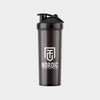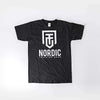How does Smelling Salt work?
Smelling Salt works by releasing ammonia vapor, which irritates the airways and activates the body’s fight-or-flight response. This leads to increased adrenaline production, a higher heart rate, and improved blood flow to the muscles. It has long been used by strength athletes to prepare for heavy lifts.
What does Smelling Salt do?
Smelling Salt releases ammonia (NH3) gas, which triggers an inhalation reflex by irritating the mucous membranes in the nose and lungs. This makes you more alert, focused, and ready to perform at your best.
When should you use Smelling Salt?
You can use our Smelling Salt in many different situations. During strength training, for example, you might use it before your heaviest lift, such as when you are aiming for a new personal record in the deadlift. Take a quick sniff, feel the effect, and then lift immediately. In other sports like hockey, you can use it right before stepping onto the ice for an extra mental boost.
How are ammonia inhalants used?
Ammonia inhalants have become increasingly popular in training environments, especially among strength athletes and others aiming to maximize performance. The effect of Smelling Salt comes from its intense scent. This strong odor irritates the nasal membranes, increasing breathing rate and triggering a heightened state of alertness and focus.
In sports, ammonia inhalants are often used just before a heavy lift, an important sprint, or a decisive moment in a match. This helps athletes feel mentally sharp and ready to give their all. For strength athletes, it might mean taking a quick whiff before a max deadlift or squat, providing an immediate but short-lived energy boost.
Are there any risks with Smelling Salt?
Since Smelling Salt produces only a very small amount of ammonia gas, no negative health effects have been reported. However, inhaling a high concentration of ammonia too close to the nostrils can cause a burning sensation in the nose or mouth.
Using ammonia inhalants to revive injured athletes is not recommended, as it may interfere with or delay proper neurological assessment by medical personnel, for example after a concussion that requires hospital care. The irritant nature of ammonia can trigger reflexes in the body that may worsen back or neck injuries. For this reason, it is now banned in most boxing competitions.
Use ammonia inhalants in the gym
Ammonia inhalants are chemical compounds that emit a strong odor when exposed to air. They are usually packaged in small containers and held under the nose when an energy boost is needed.
It’s common to use Smelling Salt in the gym to gain extra energy during a tough workout or to improve focus and concentration before a heavy lift. Some athletes use ammonia inhalants as a mental or psychological trigger to boost performance. By inhaling the sharp scent, you can feel more awake and alert, which helps increase motivation and drive.
Buy Smelling Salts in Europe
We have Europes’s largest selection of Smelling Salts. Buying Smelling Salt should be affordable and convenient, which is why you can purchase them directly from our website with fast shipping from Sweden, or from one of our authorized retailers.
We produce our own Smelling Salts here in Sweden, and all our Smelling Salt products come with safety data sheets, making them fully legal for sale in Europe.
How does Smelling Salt work?
Smelling Salt works by releasing ammonia vapor, which irritates the airways and activates the body’s fight-or-flight response. This leads to increased adrenaline production, a higher heart rate, and improved blood circulation to the muscles. It has long been used by strength athletes to prepare for heavy lifts.
Smelling Salt, also known as ammonia inhalant, is now used by athletes in sports like American football, hockey, and Olympic weightlifting because its stimulating effect helps activate the entire body, according to Världens Historia.
One reason Smelling Salt has become popular in training is that it helps improve oxygen uptake, concentration, performance capacity, and alertness. It can be used shortly before a match, a heavy lift, or any other situation where peak performance is required.
When did people start using Smelling Salt?
Smelling Salt was introduced in Europe in the 18th century and was originally used for medical purposes to revive people who had fainted, often women wearing overly tight corsets. According to
Läkartidningen, this was its primary use. Today, Smelling Salt is no longer used medically but is instead applied to revive boxers or other athletes who have lost consciousness after a hard blow to the head.
Is Smelling Salt dangerous?
According to
The Swedish Poison Information Centre, inhaling high concentrations of ammonia gas can cause breathing difficulties and lung damage. However, Smelling Salt contains an extremely small amount of ammonia gas and is therefore not dangerous. No health issues have been reported from normal use.
It’s important to remember that Smelling Salt is intended for athletes and should only be used to enhance performance. Holding the container too close to the nose can cause a burning sensation that might feel uncomfortable but is not harmful. Smelling Salt should always be used with care and according to the recommended guidelines.
 Lifting Straps
Lifting Straps Lifting Belts
Lifting Belts Nordic Grips
Nordic Grips Knee Sleeves
Knee Sleeves Elbow Sleeves
Elbow Sleeves Wrist Wraps
Wrist Wraps Knee Wraps
Knee Wraps Smelling Salt
Smelling Salt Supplements
Supplements  Neoprene Shorts
Neoprene Shorts Grip Shirt
Grip Shirt Deadlift socks
Deadlift socks Gym Chalk
Gym Chalk  Lifting Shoes
Lifting Shoes Strongman Tacky
Strongman Tacky Stone Sleeves
Stone Sleeves Sandbags
Sandbags Calf & Shin Sleeves
Calf & Shin Sleeves Compression Cuffs
Compression Cuffs Accessories
Accessories
 Best Seller
Best Seller Sale
Sale News
News Lifting Straps
Lifting Straps Lifting Belts
Lifting Belts Nordic Grips
Nordic Grips Knee Sleeves
Knee Sleeves Elbow Sleeves
Elbow Sleeves Wrist Wraps
Wrist Wraps Knee Wraps
Knee Wraps Smelling Salt
Smelling Salt Supplements
Supplements  Neoprene Shorts
Neoprene Shorts Grip Shirt
Grip Shirt Deadlift socks
Deadlift socks Gym Chalk
Gym Chalk  Lifting Shoes
Lifting Shoes Strongman Tacky
Strongman Tacky Stone Sleeves
Stone Sleeves Sandbags
Sandbags Calf & Shin Sleeves
Calf & Shin Sleeves Compression Cuffs
Compression Cuffs Accessories
Accessories



 Lifting Straps
Lifting Straps Lifting Belts
Lifting Belts Nordic Grips
Nordic Grips Knee Sleeves
Knee Sleeves Elbow Sleeves
Elbow Sleeves Wrist Wraps
Wrist Wraps Knee Wraps
Knee Wraps Smelling Salt
Smelling Salt Neoprene Shorts
Neoprene Shorts Grip Shirt
Grip Shirt Deadlift socks
Deadlift socks Lifting Shoes
Lifting Shoes Strongman Tacky
Strongman Tacky Stone Sleeves
Stone Sleeves Sandbags
Sandbags Calf & Shin Sleeves
Calf & Shin Sleeves Compression Cuffs
Compression Cuffs Accessories
Accessories



